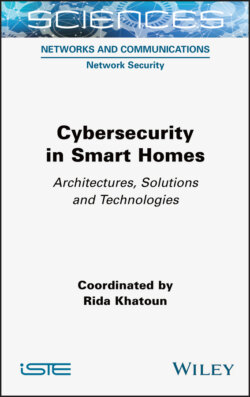Cybersecurity in Smart Homes

Реклама. ООО «ЛитРес», ИНН: 7719571260.
Оглавление
Rida Khatoun. Cybersecurity in Smart Homes
Table of Contents
List of Tables
List of Illustrations
Guide
Pages
Cybersecurity in Smart Homes. Architectures, Solutions and Technologies
1. Home Automation Solutions for SecureWSN
1.1. Introduction
1.2. Background
1.2.1. SecureWSN
1.2.1.1. CoMaDa characteristics
1.2.1.2. WebMaDa characteristics
1.2.2. Communication standards
1.2.2.1. ZigBee
1.2.2.2. Bluetooth low energy
1.2.2.3. Publish/subscribe protocols
1.2.3. The monitor-analyze-plan-execute-knowledge model
1.2.4. Hardware and libraries
1.3. Design decisions
1.3.1. Requirements
1.3.1.1. Functional requirements
1.3.1.2. Non-functional requirements
1.3.2. HAIFA architecture
1.3.2.1. Components and structure of the HA module
1.3.2.2. Expandability support
1.3.2.3. HAIFA ZigBee Gateway
1.3.2.4. HAIFA database design
1.3.2.5. HAIFA MAPE-K cycle design
1.3.3. WebMaDa integration
1.4. Implementation
1.4.1. CoMaDa integration
1.4.1.1. Interfaces and core classes
1.4.1.2. HA module
1.4.1.3. Actuator, commands and arguments
1.4.1.4. Rules and conditions
1.4.1.5. HAIFA’s gateway interface
1.4.1.6. HAIFA’s automation-worker
1.4.1.7. HAIFA’sstorageinterface
1.4.1.8. Administration frontend
1.4.1.9. Bootstrapping within the WSNFramework
1.4.1.10. Logging
1.4.2. HAIFA’s ZigBee Gateway
1.4.2.1. Installation and setup of the environment
1.4.2.2. Connection of the ZigBee adapter to Zigbee2Mqtt
1.4.2.3. Configuring and controlling the Zigbee2Mqtt bridge
1.4.2.4. Gateway implementation
1.4.3. WebMaDa integration
1.4.4. Uploading HA data to WebMaDa
1.4.5. Sending HA messages from WebMaDa to CoMaDa
1.4.6. WebMaDa’s frontend
1.5. Evaluation of HAIFA
1.5.1. Actuator interoperability (R1)
1.5.2. Rule-based automation (R2)
1.5.3. Node hardware interoperability (R3)
1.5.4. CoMaDa and WebMaDa management (R4)
1.6. Summary and conclusions
1.7. Acknowledgements
1.8. References
2. Smart Home Device Security: A Survey of Smart Home Authentication Methods with a Focus on Mutual Authentication and Key Management Practices
2.1. Introduction
2.2. Smart home – introduction and technologies. 2.2.1. Smart home – introduction
2.2.2. Smart home devices – categories
2.3. Smart home security
2.3.1. Threats
2.3.2. Vulnerabilities
2.3.3. IoT communication protocols
2.3.4. Enhancements to IoT communication protocols
2.3.5. IoT security architectures
2.4. Smart home authentication mechanisms
2.4.1. Stages of defining an authentication protocol for IoT
2.4.2. Taxonomy of authentication schemes for IoT
2.5. A primer on mutual authentication and key management terminologies
2.5.1. X.509 certificate
2.5.2. CoAP and DTLS
2.5.3. TLS 1.3
2.5.4. Key management fundamentals
Key generation
Key storage
Key agreement and transport
Key revocation
2.6. Mutual authentication in smart home systems
2.6.1. Device and user onboarding
2.6.2. Flow of user authentication and authorization
2.6.3. Examples of mutual authentication schemes
2.7. Challenges and open research issues
2.8. Conclusion
2.9. References
3. SRAM Physically Unclonable Functions for Smart Home IoT Telehealth Environments
3.1. Introduction
3.2. Related literature
3.3. System design considerations
3.4. Silicon physically unclonable functions (PUF)
3.4.1. Mutual authentication and key exchange using PUF
3.4.2. Fuzzy extractor
3.5. Convolutional encoding and Viterbi decoding the SRAM words
3.6. CMOS SRAM PUF construction
3.6.1.SRAM PUF statistical model
3.6.2.Extracting the SRAM cell statistical parameters
3.6.3.Obtaining the golden SRAM PUF memory content
3.6.4.Bit error rate (BER)
3.6.5.Signal-to-noise ratio (SNR) for SRAM PUF
3.7. Algorithms for issuing CRP
3.7.1.Algorithm #1: single-challenge
3.7.2.Algorithm #2: repeated challenge
3.7.3.Algorithm #3: repeated challenge with bit selection
3.8. Security of PUF-based IoT devices
3.9. Conclusions
3.10. Acknowledgements
3.11. References
4. IoT Network Security in Smart Homes
4.1. Introduction
4.2. IoT and smart home security
4.3. IoT network security
4.4. Prevailing standards and initiatives
4.5. Conclusion
4.6. References
5. IoT in a New Age of Unified and Zero-Trust Networks and Increased Privacy Protection
5.1. Introduction
5.2. Internet of Things
5.3. IoT security and privacy challenges
5.3.1. Security challenges
5.3.2. Privacy challenges
5.4. Literature review
5.5. Security and privacy protection with a zero-trust approach
5.6. Case study: secure and private interactive intelligent conversational systems
5.6.1. LinTO technical characteristics
5.6.2. Use case
5.6.3. Use case mapping on the reference architecture
5.7. Discussion
5.8. Conclusion
5.9. Acknowledgements
5.10. References
6. IOT, Deep Learning and Cybersecurity in Smart Homes: A Survey
6.1. Introduction
6.2. Problems encountered
6.3. State of the art
6.3.1. IoT overview
6.3.2.History
6.3.3. Literature review
6.3.4. Advantages, disadvantages and challenges
6.3.4.1. Advantages
6.3.4.2. Disadvantages
6.3.4.3. Challenges
6.4. IoT architecture
6.4.1. Sensing layer
6.4.2. Network layer
6.4.3. Service layer
6.4.4. Application-interface layer
6.5. IoT security
6.5.1. Security in the sensing layer
6.5.2. Security in the network layer
6.5.3. Security in the service layer
6.5.4. Security in the application-interface layer
6.5.5. Cross-layer threats
6.5.6. Security attacks
6.5.6.1. DoS attack
6.5.6.2. Replay attack
6.5.6.3. Eavesdropping
6.5.6.4. Physical attacks
6.5.6.5. Man-in-the-middle attack
6.5.6.6. Data modification
6.5.6.7. Spoofing
6.5.6.8. Sniffing attack
6.5.7. Security requirements in IOT
6.5.8. Security solutions for IOT
6.5.8.1. Security solutions in sensing layer
6.5.8.2. Security solutions at the network layer
6.5.8.3. Security solution at the service layer
6.5.8.4. Security solutions at the application-interface layer
6.6. Artificial intelligence, machine learning and deep learning
6.6.1. Artificial intelligence
6.6.2. Machine learning
6.6.3. Deep learning
6.6.4. Deep learning vs. machine learning
6.7. Smart homes
6.7.1. Human activity recognition in smart homes
6.7.2. Neural network algorithm for human activity recognition
6.7.3. Deep neural networks used in human activity recognition
6.8. Anomaly detection in smart homes. 6.8.1. What are anomalies?
6.8.2. Types of anomaly
6.8.3. Categories of anomaly detection techniques
6.8.4. Related work of anomaly detection in smart homes
6.9. Conclusion
6.10. References
7. sTiki: A Mutual Authentication Protocol for Constrained Sensor Devices
7.1. Introduction
7.2. Definitions and history of IoT
7.3. IoT-related security concerns
7.3.1. Security analysis guidelines
7.3.2. Security analysis by threat models
7.3.3. sTiki’s security expectations
7.4. Background knowledge for sTiki
7.4.1. Application dependencies for sTiki
7.4.2. Inspiring resource-efficient security protocols
7.5. The sTiki protocol
7.5.1. Design decisions taken
7.5.2. Implementation of sTiki’s components
7.5.2.1. sTiki’s node implementation
7.5.2.2. sTiki’s key server implementation
7.6. sTiki’s evaluation
7.6.1. Secured communication between aggregator and server
7.6.2. Secured communication between collector and aggregator
7.6.3. Communication costs
7.6.4. Integration into an existing system
7.6.5. Comparison to existing approaches
7.7. Summary and conclusions
7.8. Acknowledgements
7.9. References
List of Authors
Index. A, B
C, D
H, I
L, M
N, O
P, S
U, Z
WILEY END USER LICENSE AGREEMENT
Отрывок из книги
Networks and Communications, Field Director – Guy Pujolle
.....
Network Security, Subject Head – Rida Khatoun
Coordinated by
.....